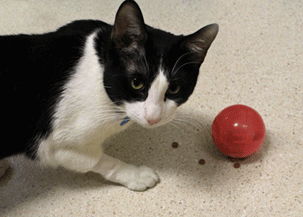

What is a puzzle feeder? Basically, the human places the pet's food inside compartments which require the pet to put forth some effort and agility before they can gain access to the food.
Puzzle feeders provide several benefits — they greatly slow down the pet's eating (likely reducing caloric intake), they provide enrichment ("mental stimulation", more or less), and they somewhat increase a pet's activity level. It's a win-win-win.
There are MANY different types of puzzle feeders, anything from a piece of food buried in crinkled-up newspaper, to toys that require multiple steps before the food becomes accessible.
They're also much cheaper than automatic feeders, but provide many of the same benefits. If a cat is provided a few puzzle feeders at bedtime, they will hopefully be kept occupied enough that they won't interrupt your sleep, even though they're being provided reduced calories.
The general advice is to provide your cat a very gentle introduction to puzzle feeders, starting out with extremely easy puzzle feeders and only progressing to more difficult ones as your cat gains proficiency. You want to avoid making your cat feel frustrated by an overly difficult puzzle.
If you google "puzzle feeder", you get a long list of people wanting to sell you something. But you actually don't have to spend much money at all — there are plenty of plans available for DIY puzzle feeders.
Bonus, they're a great way to recycle your trash.
The gold-standard for feeding multiple cats different diets is the microchip cat feeder. However, the fact that owners usually need more than one microchip feeder means that it's a very expensive solution. ($400-700, depending on the number of unique diets or number of cats)
Puzzle feeders may be a viable alternative. Initially, each cat may focus on a different type of puzzle feeder, totally arbitrarily. But over time, each cat gains more experience at their own niche of puzzle feeders, while the other cats remain naive to that niche. At that point, it's simply a matter of matching the necessary diet to the preferred type of puzzle feeder.
(but there are other cheap solutions to this problem as well)
With so many benefits, are there any downsides?
Well, yes. It does take a little more time to put out new food, as compared to topping up a typical pet dish. One way to deal with this is to fill up all your puzzles at once, and store them in a sealed container until they're needed a few days later.